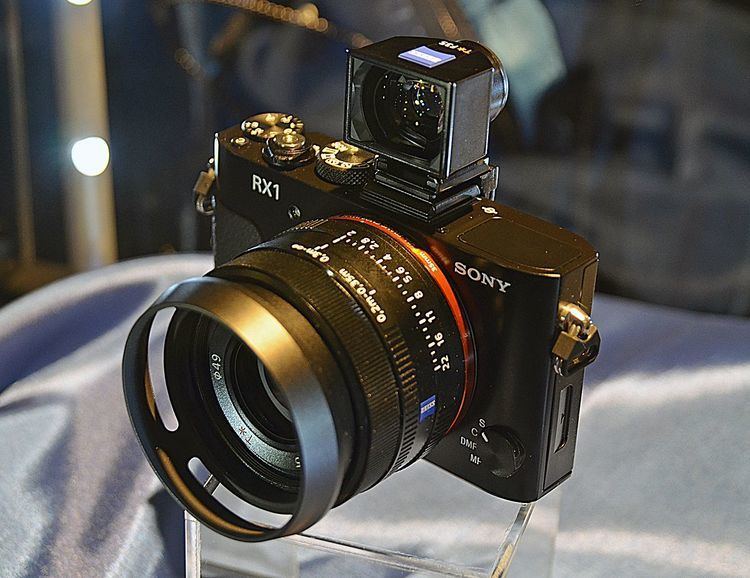 | ||
The Sony RX is a range of high-end cameras created by Sony starting in 2012.
Contents
Presentation
This series of high-end devices is intended for an audience of discerning photographers, enthusiasts and even professionals. The range was introduced in 2012 by the RX100 is the most affordable model in the range, proposed €600 to launch the RX1 appears a few months later for professionals, is launched to €3200. A year later released the RX10 priced at €1300. All units are equipped with optical Carl Zeiss which has already developed in the past, many targets for SLR and Hybrid range Alpha. The RX series broadly meets a critical and commercial success. Thus, the RX100 experts compact placed Sony topped the sales in this segment in two years, while the brand was absent from this market before. RX100 and was designated as one of 25 best inventions of 2012 by Time .
RX1
The RX1 was released in late 2012, he is an expert compact with a sensor full size 24 megapixel (notably used by the Alpha 99), the sensitivity ranges from 100 to 25600 ISO. The target has a zoom 35 mm and aperture f / 2. The device has a screen of 7.5 cm diagonal and a resolution of 1229000 point.
RX1R
Released in the summer of 2013, it is a derivative of RX1 without a low pass filter, as a full hybrid brand format, the Alpha 7R.
RX1 II
Scheduled for 2015, this future model should be the first full-frame camera to incorporate a curved curve sensor. It should receive a new target 35 mm with a larger aperture to f/1.8. These two improvements should allow the device to offer better performance in low light and to have made more uniform throughout the image.
RX10
The RX10 was released in late 2013, it is a bridge expert equipped with a 1" sensor (four times larger than those of conventional bridges) 20 megapixels, the sensitivity extends from 125 to 12800. (expandable to ISO 74) The target has an equivalent focal range 24–200 mm (zoom 8.3x) and an aperture constant f/2.8. The device has a screen of 7.5 cm of diagonal and a resolution of 1228800 point.
RX10 II
The RX10 II is marketed in July 2015, it boasts a new faster sensor generation (Exmor RS) and the video 4K. The autofocus progresses with 0.9 seconds on a moving object. The maximum shutter speed is 1/32000 seconds, the burst passes 16 i/s.
RX10 III
March 2016 Sony introduced the third version of its RX10 camera, the III. It is basically the same as the RX10 II, except for a new, longer 24-600mm f/2.4/4 lens.
100 Series
.
RX100
The RX100 is released during summer 2012, he is an expert compact with a sensor 1 "(four times larger than those of conventional compact) 20 megapixels, the sensitivity ranges from 80 to 6400 ISO. The target has an equivalent focal range 28–100 mm (1.1–3.9 in) (3.6x) and an aperture of f/1.8–4.9. The device has a screen of 7.5 cm diagonal of 1230000. His target price at launch is €650.
In 2013, Hasselblad launched Stellar, based on the RX100, it used specific materials such as leather or wood. It is a device for professionals working in the middle of luxury and fashion and the celebrity s.
RX100 II
New version released in the summer of 2013. From an ergonomic point of view, this new model brings an ISO accessory shoe and a tilting screen. The technical developments concerning the sensor becomes backlit. The quality of low light images is thus improved as well as the reactivity (AF). The sensitivity range now extends from 100 to 12800 ISO. The Wi-Fi and NFC are integrated to control the camera with a smartphone through a dedicated application. The dimensions remain the same compared to the RX100, except in thickness where the Mark II takes about three millimeters. Its target price at launch was €750. and RX100 remains in the catalog.
On 26 November 2014, Hasselblad announced the Stellar II, based on the RX100 II. It is launched at 1,650 €, it replaces the first Stellar and offers several materials for grip: olive, drowning, padouk and carbon fiber.
RX100 III
Announced on 15 May 2014 and marketed in the month of July following, this new version offers a wider aperture telephoto, it increases from f/4.9 to f/2.8. The focal range is modified to receive more wide angle, it is equivalent to 24–70 (2.9x zoom). A new version of the microprocessor BIONZ (referred to as "X") more powerful and faster born. The housing incorporates an electronic viewfinder pop-up (a definition identical to that of the Alpha 6000), like a flash (the latter taking the place of the ISO label, which disappears ). The sensitivity is further enhanced with a range of from 125 to 25600. The screen offers an expanded orientation with an angle of 180° up and 45° down, in particular to promote selfies. The dimensions remain the same compared to the RX100 II, except thick where the Mark III takes about three millimeters. The RX100 III, sold at 850 €, does not replace the previous RX100 remaining for sale at a reduced price allowing Sony to offer a range of compact cameras experts.
RX100 IV
The RX100 IV is marketed in July 2015, it boasts a new faster sensor generation (Exmor RS) and the video 4K. The autofocus progresses with 0.9 seconds on a moving object. The maximum shutter speed is 1/32000 s, the burst passes 14 i/s.
